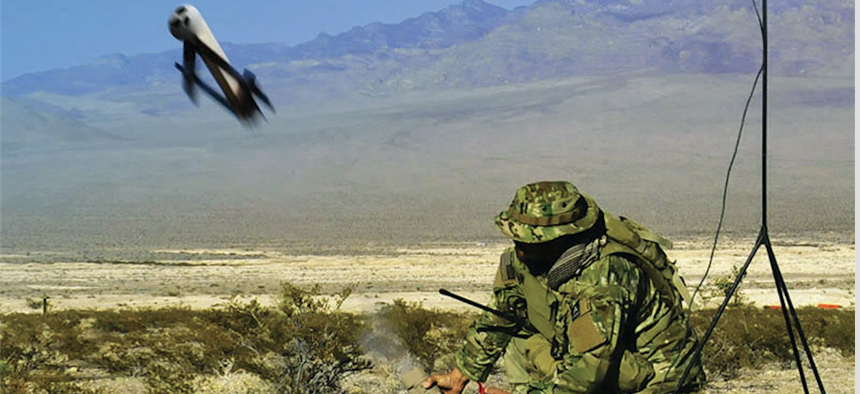
The AeroVironment Switchblade AeroVironment
In Urgent Request, US Special Ops Adds 350 Kamikaze Drones to Fight ISIS
And that's not all. The command is also opening a drone-hacker lab to help keep up with ISIS weaponeers.
TAMPA, Florida — Here’s how Mad Max the situation in Iraq is right now. Earlier this year, the military put out an urgent request for inexpensive kamikaze drones that special operations troops could fire from handheld bazooka-like launchers against ISIS, according to documents obtained by Defense One. It’s another sign that drone warfare is changing far faster than traditional military equipping can keep up, a fact reinforced this week by leaders with U.S. Special Operations Command, or SOCOM.
In its Joint Urgent Operational Needs Statement, SOCOM requested 325 “Miniature Aerial Missile Systems,” or LMAMS, by summer. That delivery has already been completed. AeroVironment officials confirmed to Defense One that they recently delivered about 350 Switchblades, a tube-launched drones outfitted with cameras and cursor-on-target GPS navigation. The company bills the device as a “miniature flying lethal missile can be operated manually or autonomously.” It can fly for about 15 minutes, at up to 100 miles per hour. The Pentagon put a similar request for Switchblades back in 2013.
Special operations forces have highlighted the need for new types of drones, or drone missiles, to strike rapidly adapting non-state enemies like the Islamic State. To help drive innovation, U.S. Special Operations Command intends to open a hacker lab in Tampa as part of the broader SOFWERX initiative.
“The threat is really changing — this explosion of commercial technology, of super-empowered commercial technology, of each individual technology path on an accelerated schedule,” James “Hondo” Geurts, who leads SOCOM’s acquisitions, technology and logistics efforts, said Tuesday at a National Defense Industry Association event here. “When you start stacking accelerations on top of each other, pretty soon you’ve got autonomous swarms of drones with facial recognition attacking you on the battlefield. And so how do you get out in front of that?”
Army Col. John Reim, who outfits special operations troops as head of SOCOM’s Warrior program office, said he needs missile drones that can blow up bigger targets.
“We have a good capability right now with the Switchblade. But it’s got a smaller payload. How do you get a little larger?” Reim said. “We’re trying to create organic firepower and situational awareness in so many of the places we operate in.”
Basing becomes an issue, he said.
“In Africa, for instance, you can’t rely on the high-end fast movers” — large, expensive drones such as General Atomics’ MQ-9 Reaper, he said. “You need a common launch-tube-type configuration, man-packable. You need to be able to throw it on a truck.”
The U.S. military isn’t alone in rapidly experimenting with new types of drones. During a recent visit to Mosul, Iraq, SOCOM commander Gen. Ray Thomas said he ran into a pair of operators who had found an off-the-shelf rotary-wing quadcopter adapted by ISIS weaponeers to carry a 40 mm weapon.
“This is how adaptive the enemy was,” Thomas said. “About five or six months ago, it was a day that the Iraqi effort almost came to a screeching halt. Literally in the span of 24 hours, there were up to 70 drones in the air. At one time, 12 ‘killer bees,’ if you will, right overhead.”
It was about that time that SOCOM began working with the Johns Hopkins Applied Physics Lab to take the devices troops use to detect and jam improvised explosive devices, and convert them into drone jammers.
“The Johns Hopkins Applied Physics Lab was able to really help us out,” said Reim. “We’ve made some initial progress. I’ve got an initial capability out now. How do I do a better job at the detection piece, the defeat piece?”
NEXT STORY: Stop Blaming the NSA for the Ransomware Attack




